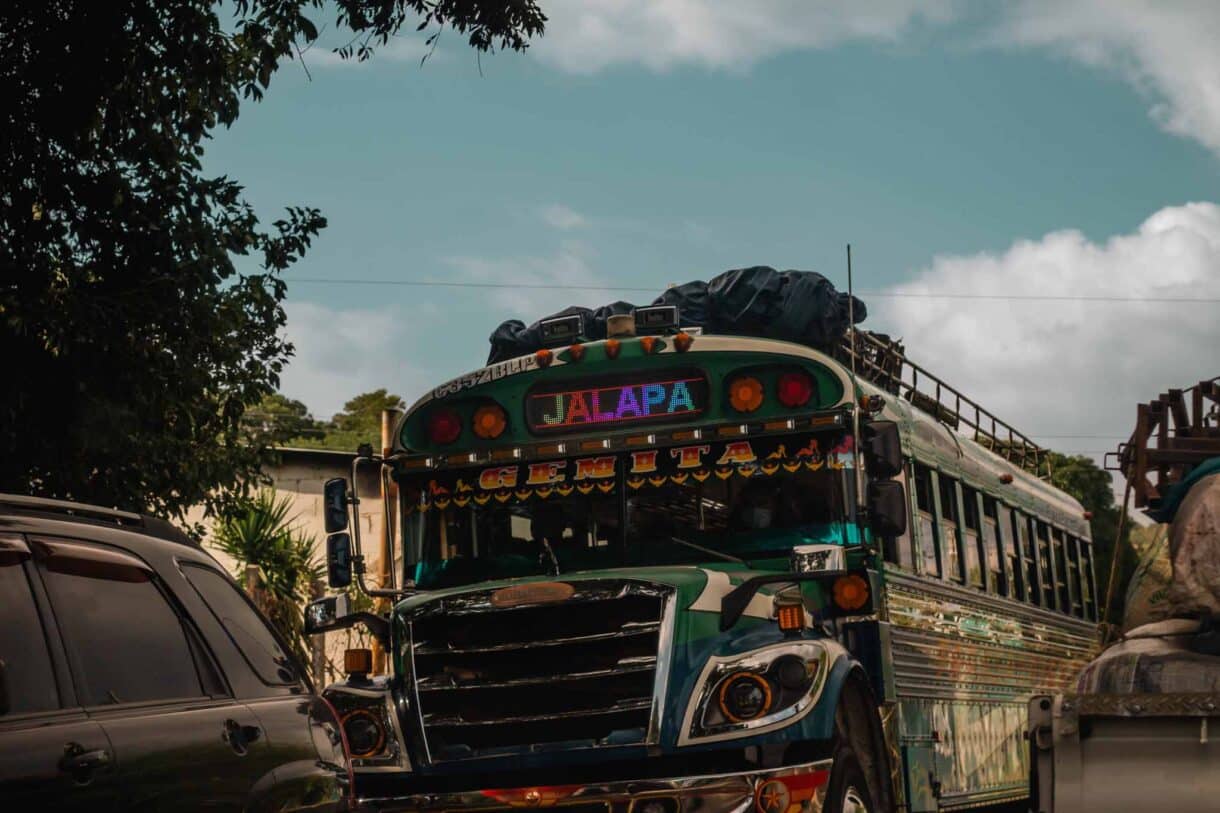
Chicken Buses in Central America: The Ultimate Guide
One of the most unique and vibrant experiences you can have while travelling through Central America is hopping on a ‘chicken bus’.
This unique form of transportation – only called ‘chicken buses’ by tourists – has been around for decades. These lively vehicles are the local transport in Central America: mainly in Guatemala, Nicaragua, El Salvador and Honduras. And the ‘chicken bus’ is not your typical bus; they are a spectacle of colour, culture, and character that perfectly encapsulate the region’s spirit. They’re also an incredibly affordable (and fun!) way to get around.
So what are you waiting for, hop in?
WHAT IS A CHICKEN BUS?
If you’re planning a trip to Central America, you’ll probably have stumbled across the term ‘chicken bus’. This distinctive mode of transport serves as both the practical choice for locals going about their daily lives, and a delightfully affordable adventure for curious travellers.
You’ll mostly find chicken buses in Guatemala, El Salvador, Honduras, and Nicaragua (but maybe more modern, or less crazy versions in Mexico, Costa Rica, and Panama too!). And don’t worry, the locals don’t usually use them to transport chickens anymore.
These brightly-coloured buses are actually old yellow school buses that were auctioned off in the United States once they get too old, or have driven too many miles. After being purchased, entrepreneurs in Central America transform these buses into works of art.
It’s these artistic (and often personal) touches that make chicken buses an instantly recognisable explosion of colour, light, and sound. Brightly painted, some buses even feature fun club-like lighting and full sound systems inside, turning a simple ride into a lively party on wheels. Among the colourful artwork, you’ll often find religious sayings like “Jesus is my driver” or “God is Love”; a reminder of the importance of Catholicism for many across Central America.
While the original reason for the name might be less common nowadays, the charm of the Chicken Bus lives on. These buses have become more than just a mode of transportation; they are an experience in themselves (albeit a sweaty, slightly uncomfortable one). So, if you want a truly unique adventure while traveling through Central America, don’t miss the chance to hop on a chicken bus and immerse yourself in the lively, colorful world of local travel.
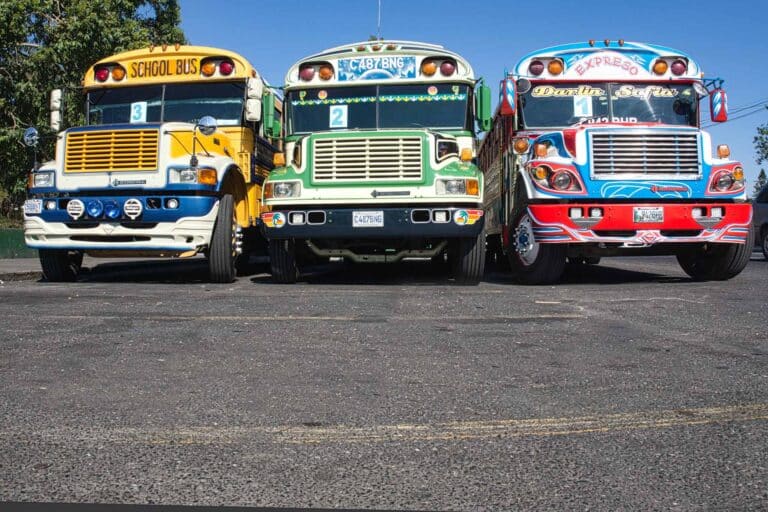
WAIT... WHY ARE THEY CALLED CHICKEN BUSES?
Have a guess? These lively buses were dubbed ‘chicken buses’ by tourists in Guatemala who were excited to see locals using the bus to transport small farm animals, including chickens.
It’s less common to see animals today – we didn’t see any – but the name still stuck and spread across the rest of Central America.
Other names for public buses in Central America include “el autobús”, “la camioneta,” “la burra,” or simply “el bus.”. If you can only remember one of these, remember “el autobus”: it’s not the most commonly used, but it’s the official word for bus throughout Latin America that everyone will understand.
Top tip: If you really want to see chickens on the bus, head to more rural areas on market days. You’ll almost certainly see them at Chichicastenango market in Guatemala, a small detour from Lago Atitlan .
HOW TO TAKE A CHICKEN BUS IN CENTRAL AMERICA: A QUICK GUIDE
In a hurry and don’t have time to read the full article?
Riding chicken buses in Central America can be an adventure in itself. To make the most of your journey, here are the key things to keep in mind:
🚌 Locating Your Bus: You can find a local bus at a terminal or simply flag one down on the road.
🗺️ Confirm the Route: While the final destination and route are usually displayed on the bus, it’s a good practice to double-check with the driver when you board.
🎟️ Paying Your Fare: You’ll need to pay the fare, either to the driver or their assistant known as “el ayudante.” Sometimes, they collect it after you’ve taken your seat.
🎒 Baggage Considerations: If you have a large bag, they might charge you extra. Don’t worry if they want to stow your bag on the roof.
👨👩👧👦 Mind the Crowds: These buses tend to get crowded, so grab a seat if you can and be mindful of your belongings.
📍 Getting Off: Don’t hesitate when it’s time to disembark. If it’s not a popular stop, you might need to wave your arms or raise your voice so the driver can hear you.
Embrace this genuine local experience and enjoy the colourful journey!
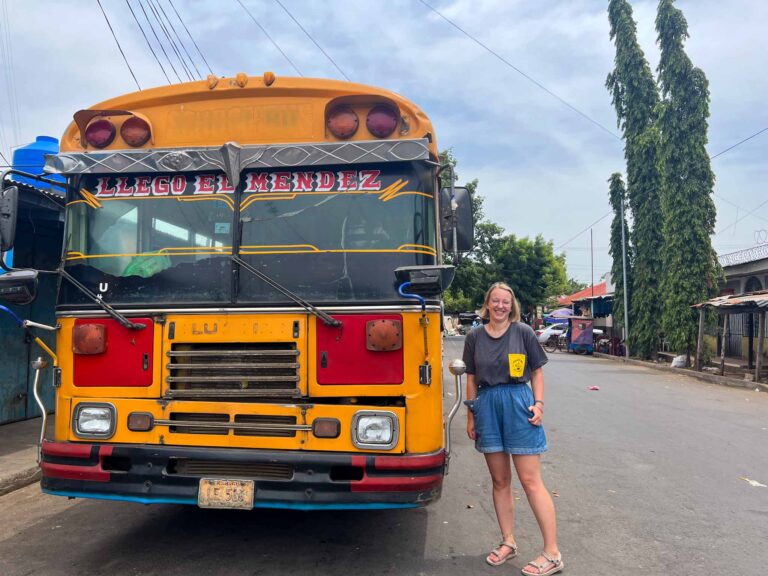
HOW TO TAKE A CHICKEN BUS IN CENTRAL AMERICA: A MORE DETAILED GUIDE
#1 HOW TO STOP A CHICKEN BUS
Stopping a chicken bus in Central America might seem like a daunting task, but it’s easier than you think. Chicken buses follow a fixed route along main roads between cities and villages. There aren’t really fixed bus stops – there might be the occasional bus shelter to protect you from the sun (or torrential rain) – but you can get on wherever you want on the route.
Simply stand by the side of the road and wait. Chicken buses have their final destination and/or route written at the front and, usually at the back too. Once a bus with your destination drives by, wave your arms, and make eye contact with the driver or conductor. The ayudante (ticket conductor) will usually be hanging out of the bus shouting the destination too. They’ll usually stop to pick you up. Remember, confidence is key – so put your hand out and get ready to embark on a vibrant journey through Central America.
You can confirm with the driver (in Spanish) that the bus is heading where you want to go. Most drivers don’t speak English, but if you don’t speak Spanish, simply saying the name of the destination is usually enough. We did this every time, no matter how confident we were that we were on the right bus.
#2 HOW TO GET ON A CHICKEN BUS
Getting on a chicken bus is easy. Once you wave for the bus to stop, it will usually stop right in front of you. Wait for the bus to come to a complete stop, and then climb aboard. Most buses have an assistant (“ayudante” or “el brocha”) who will open the door and assist you. If you’ve got a large backpack, they might ask to put it on the roof! This is totally normal. Just remember to ask for it back when you get off.
Getting on a chicken bus is easy. Once you wave for the bus to stop, it will usually stop right in front of you. Wait for the bus to come to a complete stop, and then climb aboard. Most buses have an assistant (“ayudante” or “el brocha”) who will open the door and assist you. If you’ve got a large backpack, they might ask to put it on the roof! This is totally normal. Just remember to ask for it back when you get off.
#3 HOW TO PAY FOR THE CHICKEN BUS
Sometimes the driver will collect the fare as you board, but oftentimes the ayudante. will come round and collect the fare in cash after you sit down. The fare for a ride will remain the same whether you stay on the bus for 1 minute or 1 hour. Though getting change isn’t often an issue, it’s best to have smaller bills or coins, as they might not always have change for larger denominations. Pay the exact fare if possible (or close to it!) to avoid any confusion or issues.
In some countries, like El Salvador, the fare is printed at the front of the bus and you’ll pay the same as the locals without a problem. Other countries (looking at you, Nicaragua), might be less honest and try and get away with a little ‘tourist tax’ since they think you don’t know any better.
Whilst I won’t quibble over paying a little extra, I recommend either a) checking with your hotel or hostel how much the fare should cost for your journey, or b) asking a local on the bus (“Cuánto cuesta” – “how much does it cost”). Pay in exact change with confidence, and don’t be afraid to negotiate.
Top tip: The ayudante hasn’t stolen your money! Once you’re aboard, the ayudante will come and take your payment. If neither of you have the right change to give, he’ll probably take your money and walk off to see to other passengers. But don’t worry, he’ll come back later once he’s got the correct amount to give you. If you get given a ticket with how much change you’re owed you can cash it in just before you get off the bus.
WAIT... ARE CHICKEN BUSES EXPENSIVE?
Chicken buses CHEAP! They’re the main form of transport for local people, which makes them a truly budget friendly option for travellers. For most short journeys, expect to pay under a dollar: in Honduras and El Salvador a two hour journey will cost pennies. Even longer trips typically won’t cost more than ten dollars. I think the most we paid was 8 USD.
We found chicken buses in Guatemala to be significantly more expensive than those elsewhere in Central America. With the amount of changes needed to get from A to B, it was sometimes more economical to take private coaches in Guatemala, especially for longer journeys upwards of a few hours.
#4 SIT BACK AND RELAX
Time to enjoy the journey! Watch the world go by and take in the scenery. There’s no AC, but if you get hot, you can open up a window. There’ll be people jumping on and off the bus to sell you all kinds of snacks, sweets, water, and drinks if you’re hungry or thirsty.
Chicken Buses are a community affair, so don’t be surpised if someone asks you to watch their child or hold their bag whilst they sort something out. People will want to help with your journey and maybe have a chat. Although increasingly tourist-friendly, many parts of Central America still see foreign visitors as a novelty. This is especially true if you go to places that are off the beaten track, such as less-travelled Honduras and El Salvador, and even areas of Nicaragua and Guatemala.
Embrace the attention; it’s an authentic experience. With a little Spanish, you’ll discover a real warmth from locals, who are often genuinely interested in your travels and experiences. Do you like their country? What have you seen? Are people being kind to you? Why are you on the local bus? You will have some of your best (and craziest) experiences on Chicken Buses so EMBRACE IT!
#5 HOW TO GET OFF A CHICKEN BUS
The ayudante will usually shout the name of any major locations you’re passing, but you can get off whenever.
As there are no bus stops, and no bell to ring to call for your bus stop, you’ll need to take a more active approach! Signal the driver or ayudante by standing up, grabbing your bags, and shouting “parada” or “baja aquí” (stop here) and the bus will pull over. You’ll want to do this literally moments before you want to get off. Be mindful of your surroundings, and step off carefully – sometimes there’s a door at the back which you may want to use.
If you’re not too confident with your communication skills, it might be easier to get off when someone else does, if it’s not too far from your final destination. Don’t forget your bag if it was put on top of the bus, the ayudante will get this down for you using a lowering rope!
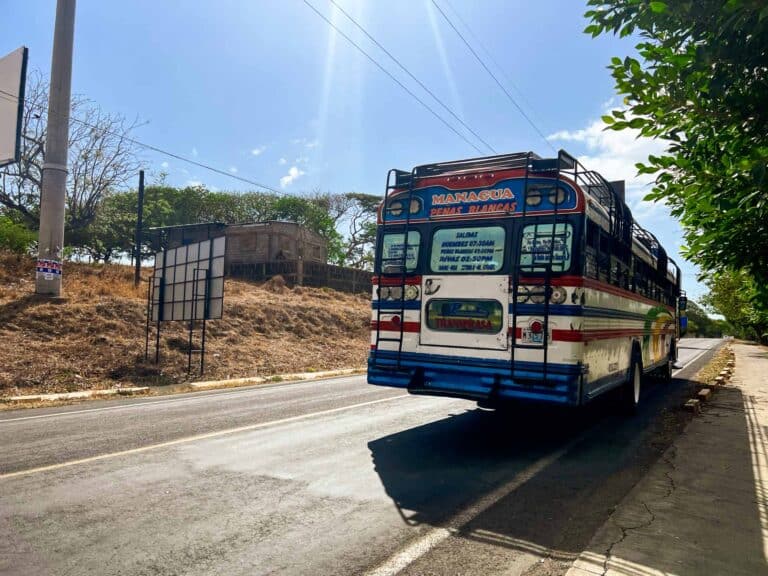
ARE CHICKEN BUSES SAFE?
Chicken Buses are mostly safe and I will always recommend them to other travellers, but like all transport in Central America (or anywhere in the world, for that matter), nothing is risk-free.
We rode local buses from Panama to Mexico, including all the way through Nicaragua, El Salvador and Honduras (countries with bad reputations for both petty and serious crime). We didn’t run into any major issues. The people were authentic, kind, and proud of their country. The driving was… maybe not quite what we were used to. But the drivers know the roads and know where they can take risks (and where they can’t!).
The worst thing we experienced was a breakdown. The driver and bus boy jumped out with a bag of tools, and we were on our way within 30 minutes. Clearly, this happened often!
None of the other travellers we met on our journey had had any issues with the local transport either. However, we did travel as a pair and stick to the main tourist routes and cities, which are typically safer. We avoided the larger, more dangerous cities where crime may be more prevalent (except to transit through), and always travelled during the day.
A WORD OF WARNING...
Yes, things can happen. Apply some common sense and be aware of your surroundings and your belongings. Don’t flash your valuables around. Keep anything you care about close to you (for us, that meant passports and backup US dollars in a money belt). Stay awake – yes, I know it’s hard in the heat – and always have an eye on your luggage. Listen to locals; if multiple people are warning you against public transport, take their advice. And avoid travelling through large cities (Guatemala City, San Salvador, and Tegucicalpa and San Pedro Sula, Managua) at night, as gang violence is common and this is when buses are more likely to be stopped and robbed.
THE BIGGEST DANGER: BUS ACCIDENTS
The biggest danger when riding a chicken bus in Central America is not being robbed at gunpoint, or having your valuables stolen. It’s the risk of being in a traffic accident. Chicken buses are high speed buses with no seat belts, packed over capacity, with drivers who often seem to think they’d be better suited for Formula 1 racing.
I was surprised at how fast the buses wheeled around corners on windy roads. And if you’re standing, you really need to hold on. One of the scariest moments was when we were squeezed into the doorway of a very packed bus. Every time we turned a corner, the broken door slid open. I thought my sweaty hands were going to slip and that I’d fall out onto the motorway!
HELPFUL SPANISH PHRASES FOR BUS TRAVEL IN CENTRAL AMERICA
Take a screenshot of these helpful phrases:
- Estación de autobús (Bus station)
- Compramos el boleto aquí? (Do we buy the ticket here?)
- Cuánto cuesta un boleto a…? (How much is a ticket to … ?)
- A qué hora sale el último autobús? (What time does the last bus leave?)
- A qué hora llegará este autobús? (What time will this bus arrive?)
- ¿Vamos al centro de la ciudad? (Are we going to the city center?)
- Parada, por favor. (Stop, please.)
WHY YOU SHOULD DEFINITELY TRY A CHICKEN BUS IN CENTRAL AMERICA?
Chicken buses serve as the heartbeat of local travel, connecting towns and cities in a way that’s both economical and culturally enriching. Riding one means becoming a part of the local rhythm. You’ll get to see the real side of the places you’re visiting, and not just the shiny side that they safe for the tourists.
Plus, they’re incredibly cheap! You’ll save so much money and have experiences you would have missed otherwise. You’ll have a mad, crazy, and chaotic time, but it’s 100% worth it. Don’t leave without riding one of these famous colourful buses. I promise you’ll have some interesting stories to tell.
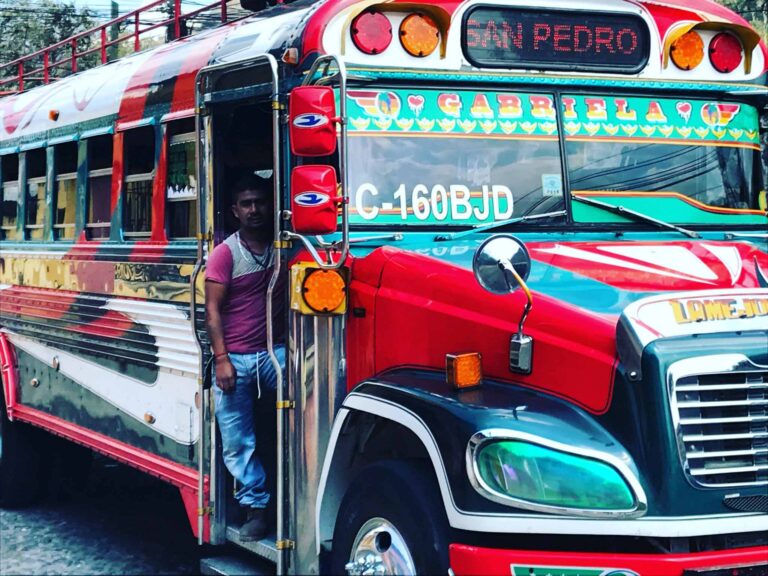
FAQs
WHAT IS A CHICKEN BUS IN CENTRAL AMERICA?
Chicken buses are the unofficial name for vibrant, repurposed American school buses used as public transportation across Central America. They offer an affordable means of transportation for locals and can be a fun experience for travellers.
CAN YOU TRAVEL THROUGH CENTRAL AMERICA BY BUS
You definitely can! We did just that, from Panama to Mexico, and had an excellent time. Chicken buses are the most popular way to do this as they are affordable and efficient. You can also take more expensive, private buses between popular tourist destinations, which may be more comfortable.
WHICH COUNTRIES HAVE CHICKEN BUSES?
Chicken buses, or similar repurposed school buses used for public transportation, are primarily found in Central American countries, such as Guatemala, El Salvador, Honduras and Nicaragua. You may also see them in parts of Mexico and Panama.
ARE THERE CHICKEN BUSES IN MEXICO?
Yes, similar repurposed school buses used for public transportation, are also common in Mexico, particularly in the regions towards the south. However, the term “chicken bus” might not be as widely used in Mexico as it is in Central American countries.
WHERE DO THEY GET CHICKEN BUSES?
Chicken buses are typically retired American school buses that are sold at auctions in the United States. These vehicles are no longer deemed suitable for use in the USA, either due to age or mileage. They are purchased, refurbished, repainted, and transformed into the lovable vibrant buses that you see across Central America.
WILL I GET PICKPOCKETED ON CHICKEN BUSES?
Central America has its fair share of crime, but instances of pickpocketing on chicken buses aren’t widespread. Chicken buses are bumpy and crowded, meaning it would be hard for an opportunistic pickpocket to take something without being noticed, or leave swiftly/disappear if caught in the act.
WILL I GET ROBBED ON CHICKEN BUSES?
There is a dark side to chicken buses, especially in Honduras, El Salvador and Guatemala. Certain chicken buses pass through poor or dangerous neighbourhoods and robberies are uncommon, but not unheard of. It’s extremely unlikely you’ll visit these areas and as such, almost all travellers have no issues on chicken buses. But listen to the locals: if they advise against travel by public transport (specifically because it’s unsafe, not because it’s uncomfortable or slow), take their advice.
ARE CHICKEN BUSES SLOW?
Chicken buses are made for local people going about their daily lives, so they’re definitely not the fastest mode of transportation. They’re old and clunky, likely to break down at inopportune moments, and tend to adhere to speed limits. As there are no real bus stops, buses also stop every 100 metres or so to let passengers on and off. This means that a trip that would normally take 30 minutes often ends up taking double that.
There is often no direct connection on a local bus between popular tourist towns, unless these towns are very close. This means you might have to change buses a couple of times before you reach your destination. However, whilst your journey might take a bit longer, the scenic routes and authentic experiences you gain are well worth the extra time.
CAN YOU CARRY YOUR BACKPACK ON CHICKEN BUSES?
We saw a lot of backpackers jumping on chicken buses with their big backpack. It’s not an issue, but once the bus gets crowded, that backpack usually has to sit on your knee, which can make for a truly uncomfortable ride. Whilst smaller backpacks can be brought on the bus, bigger bags will be thrown around, jammed in any suitable space, and often tied to the rooftop. They may get wet. They’ll probably get dusty. You don’t want to have anything you care about in your big backpack when you’re jumping on and off chicken buses in Central America.
If you can, travel with a hand-luggage sized backpack only. This means your bag can always travel inside the bus, either below the seat or on the overhead racks. You can keep an eye on your valuables, and your stuff won’t get thrown about as much!
Follow our daily adventures on Facebook and Instagram
Disclaimer: The information and advice provided in this blog are the author’s opinions and based on their personal experiences. All information was accurate at the time of writing. However, things can change quickly, so always double-check current conditions and guidelines before setting out. Remember, your travels and safety are your own responsibility, and this blog can not be held responsible for anything that might happen on your adventures! Always exercise caution and good judgment. Oh, and don’t forget to get travel insurance! Happy travels!
This post may contain affiliate links (yay for transparency!) This means that I will earn a small commission, at no additional cost to you, if you click the link and choose to buy the product. I only link to stuff I have personally bought and found useful and never endorse crap. Your support helps keep the site going, thank you!
Alice
Alice is a UK travel blogger who advocates sustainable travel and being more eco-conscious on a budget. She loves coffee, her houseplants and summiting mountains.
You May Also Like

Central America VS Southeast Asia: Where should YOU go backpacking?
June 15, 2024
From Mexico to Panama: the ultimate guide to diving in Central America
September 7, 2024